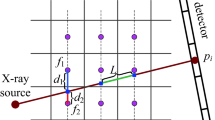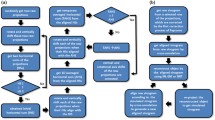Abstract
This paper suggests the implementation of an algorithm that improves the X-ray tomographic reconstruction quality of a parallel acquisition geometry by adding virtual projections to the reconstruction process in order to increase the angular resolution of the measuring device, as in the case of CT scanners. The suggested method is based on an estimated calculation of virtual projections using the zero-padding properties. The obtained results show a significant reduction of the noise effect on the reconstructed image and a remarkable quality improvement despite the use of a rudimentary tomographic device.
Similar content being viewed by others
References
M. Bertram, J. Wiegert, D. Schafer, T. Aach, and G. Rose, “Directional view interpolation for compensation of sparse angular sampling in cone-beam CT,” IEEE Trans. Med. Imaging 28 (7), 1011–1022 (2009).
Sang Don Kim and Seung Eun Lee, “Multi-energy X-ray imaging system using single photon counting,” IRECOS 8 (7), 1517–1521 (2013).
R. Gordon, “Reconstruction of surfaces from profils,” in Proc. 1st Int Conf. IEEE on Comput Vision (London, 1987), pp. 136–144.
P. J. La Rivière and X. Pan, “Mathematical equivalence of zero-padding and circular sampling thorem interpolation with implications for direct Fourier image reconstruction,” Proc. SPIE 3338, 1117–1126 (1998).
M. Endo, S. Mori, T. Tsunoo, S. Kandatsu, S. Tanada, H. Aradate, Y. Saito, H. Miyazaki, K. Satoh, S. Matsusita, and M. Kusakabe, “Development and performance evaluation of the first model of 4D CT-scanner,” IEEE Trans. Nucl. Sci. 50 (5) (2003).
W. Wagner, “Rconstructions from restricted region scan data-new means to reduce the patient dose,” IEEE Trans. Nucl. Sci. 26 (2) (1979).
G. H. Weiss, A. J. Talbert, and R. A. Brooks, “The use of phantom views to reduce CT streaks due to insufficient angular sampling,” Phys. Med. Biol. 27 (9), 1151–1162 (1982).
R. R. Galigekere, K. Wiesent, and D. W. Holdsworth, “Techniques to alleviate the effects of viewaliasing artifacts in computed tomography,” Med. Phys. 26 (6), 896–904 (1999).
K. P. Prasad and P. Satyanarayana, “Fast interpolation algorithm using FFT,” Electron. Lett. 22, 185–187 (1986).
T. J. Cavicchi, “DFT time-domain interpolation,” IEEE Proc.-F 139, 207–211 (1992).
M. Li, H. Yang, and H. Kudo, “An accurate iterative reconstruction algorithm for sparse objects: application to 3D blood vessel reconstruction from a limited number of projections,” Phys. Med. Biol. 47, 2599–2609 (2002).
A. C. Kak and M. Slaney, Principles of Computerized Tomographic Imaging (IEEE Press, New York, 1988).
Y. Li, “Interpolation based reconstruction methods for tomographic imaging in 3D positron emission tomography,” Int. J. Appl. Math. Comput. Sci. 18 (1), 63–73 (2008).
P. J. La Riviere and Xiaochuan Pan, “Comparison of angular interpolation approaches in few-view tomography using statistical hypothesis testing,” SPIE 3661, 398–407 (1999).
Author information
Authors and Affiliations
Corresponding author
Additional information
The article is published in the original.
Mohamed Reda Ahmed Bacha was born January 23, 1981 in Mostaganem, Algeria, obtained an electronics engineer degree (2003) from the University of Sciences and Technology of Oran. He obtained a master degree in Physics in 2005 and a PhD in 2015 at the Laboratory of Analysis and Application of Radiation at Physics Department of USTO. His research interest is directed to tomographic reconstruction of images.
Abdelaziz Oukebdane received his PhD degree in Nuclear Engineering from the University of Michigan in 1991. He is currently a Professor at Physics Faculty of the University of Sciences and Technology of Oran (Algeria). His current research interests include computational physics, radiation transport, medical and satellite imagery.
Ahmed Hafid Belbachir is a full professor of Physics Engineering at Physics Faculty of the University of Sciences and Technology of Oran (Algeria). He received an MSc degree in Nuclear Engineering from the University of Michigan in 1977, and a PhD in Nuclear Engineering from the same University in 1981. His research interests are laser-plasma interaction, radiation transport, detection and measurement of radiation in relation to environment and biomedical applications, imagery. He is author of numerous papers on these issues. He is currently the head of the Laboratory of Radiations Analysis and Applications at the University of Sciences and Technology of Oran (Algeria).
Rights and permissions
About this article
Cite this article
Bacha, M.R.A., Oukebdane, A. & Hafid Belbachir, A. Implementation of the zero-padding interpolation technique to improve angular resolution of X-ray tomographic acquisition system. Pattern Recognit. Image Anal. 26, 817–823 (2016). https://doi.org/10.1134/S1054661816040143
Received:
Published:
Issue Date:
DOI: https://doi.org/10.1134/S1054661816040143




